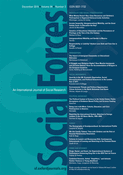-
Views
-
Cite
Cite
Seth S. Crawford, The Myth of Liberal Ascendancy: Corporate Dominance from the Great Depression to the Great Recession By G. William Domhoff Paradigm Publishers. 2013. 320 pages. $24.61 paper, Social Forces, Volume 94, Issue 2, December 2015, Page e52, https://doi.org/10.1093/sf/sou013
Close - Share Icon Share
Extract
Hunter S. Thompson's lament on the death of the American Dream situated the epicenter of an emerging cultural wave in San Francisco during the mid-1960s (Thompson 1998). To Thompson, that wave of promise—fueled by notions of economic egalitarianism, social safety nets, reasonable personal freedoms, and a belief in organic solidarity that would make Durkheim smile—broke on a hillside just outside Las Vegas, leaving the hopes and dreams of a generation unrequited. Bill Domhoff's most recent work—The Myth of Liberal Ascendancy—exposes the metaphorical underwater topography that led the wave described by Thompson to jack up and collapse (i.e., corporate domination of the policy sphere), while providing corroborating evidence that the mid-1960s were truly a high point of sorts (by several measurements).
Few serious analysts of the US power structure argue against the corporate domination thesis in the modern political scene; it's difficult to do so when corporations nakedly wield power for their benefit (federal subsidies to US firms were estimated at $100 billion in FY2012 [DeHaven 2012]) and blatantly coopt grassroots cultural phenomena (Apple's latest operating system is named after the little-known “Mavericks” surf break outside Santa Cruz). What is not so clear is the historical arc of corporate domination: when and how did it truly emerge?



